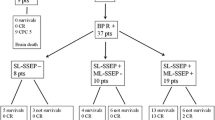Summary
Somatosensory evoked potentials (SEP) were recorded in 9 patients with vasospasm caused by subarachnoid haemorrhage.
There was a correlation between SEP changes and clinical outcome evaluated one month after onset.
And, evaluation of SEP changes under induced hypertension or infusion of dehydrates was available to study the nature of ischaemic brain dysfunction caused by vasospasm.
Furthermore, this study suggests that the available period of induced hypertension may be short in cases with severe clinical outcomes.
Similar content being viewed by others
References
de Araujo, L. C. Zappulla, R. A., Yang, W. C., Hollin, S. A., Angiographic changes to induced hypertension in cerebral vasospasm: Case report. J. Neurosurg.49 (1978), 312–315.
Ito, Z., Hen, R., Nakajima, K., Suzuki, A., Uemure, K., Selection of completed stroke patients for STA-MCA anastomosis based on measurements of somatosensory evoked potential and CBF dynamics. In: Microsurgery for Stroke (Schmiedek, P., ed.), pp. 177–184. New York: Springer. 1977.
Ito, Z., Suzuki, A., Hen, R., Nakajima, K., Preoperative evaluation of reversible cerebral hypofunction in completed stroke for superficial temporal-middle cerebral arterial bypass. In: Neurological Surgery (Carrea, R., ed.), pp. 233–239. Amsterdam: Excerpta Medica. 1978.
Kosnik, E. J., Hunt, W. E., Postoperative hypertension in the management of patients with intracranial arterial aneurysms. J. Neurosurg.45 (1976), 148–154.
Sakurai, Y., Ito, Z., Uemura, K., Pathophysiological aspects of acute stage patients with ruptured intracranial aneurysms. Part II: Relationships between neurological prognosis and sequential changes of cerebral blood flow dynamics. Brain Nerve (Tokyo)27 (1975), 1213–1221.
Symon, L., Disordered cerebro-vascular physiology in aneurysmal subarachnoid haemorrhage. Acta neurochir. (Wien)41 (1978), 7–22.
Symon, L., Hargadine, J., Zawirski, M., Branston, N., Central conduction time as an index of ischaemia in subarachnoid haemorrhage. J. neurol. Sci.44 (1979), 95–103.
Vander Ark, G. D., Pomerantz, M., Reversal of ischaemic neurological signs by increasing the cardiac output. Surg. Neurol.1 (1973), 257–258.
Author information
Authors and Affiliations
Rights and permissions
About this article
Cite this article
Suzuki, A., Yasui, N. & Ito, Z. Brain dysfunction following vasospasm evaluated by somatosensory evoked potentials. Acta neurochir 63, 53–58 (1982). https://doi.org/10.1007/BF01728855
Issue Date:
DOI: https://doi.org/10.1007/BF01728855




